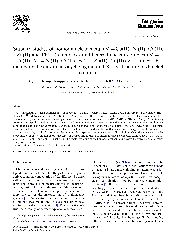摘要
A dinucleating hexaazadiphenol macrocyclic ligand, 3,6,10,18,22,25-hexaaza-31,32-dihydroxy-14,29-dimethyl-tricyclo[25,3,1,(11,17)] dotriaconta-1(30),12,14,16(32),27,28-hexaene (L or BTBP) forms a number of protonated or hydroxc, mononuclear, homodinuclear, and heterodinuclear complexes with divalent metal ions Cu(II), Ni(II), Cd(II), Zn(II) and Pb(H). Their stability constants and species distributions as a function of pH are determined. The pH potentiometric studies show that the dinuclear complexes are formed via the mononuclear chelates in which two kinds of coordination patterns were observed. One is that metal ions bind half of the coordination sites of macrocycle (N3O-), and another is that metal ions occupy salen-like sites of the macrocycle (N3O22-), In 2:1 systems the mononuclear species predominate in acidic solution while the dinuclear species predominate in basic solution except the cases of copper and nickel. The heterodinuclear complexes form [CuML] (M = Ni(II), Zn(II), Fe(II), Co(II) and Cd(II)) in solution. The crystal structure of the homodinickel complex showed that two phenolate groups bridge two Ni ions.
- 出版日期2002-10-14
